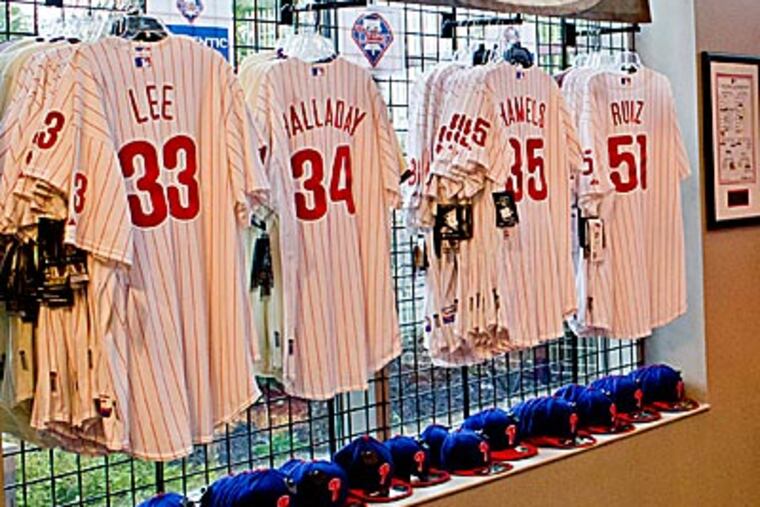Phillies merchandise sales decline
A typical crowd at Citizens Bank Park is so saturated with team merchandise that it sometimes looks as if a red-and-white flavored scene has been staged for a Phillies commercial.

A typical crowd at Citizens Bank Park is so saturated with team merchandise that it sometimes looks as if a red-and-white flavored scene has been staged for a Phillies commercial.
The ballpark's parking lots, where Phillies flags flutter like the banners of a great army, are filled with cars bearing team decals, license-plate frames, antenna pennants.
Thousands of fans who emerge from those vehicles are wearing team jerseys or T-shirts, and many are additionally equipped with club-related products from their tops (the familiar red hats or the newest sensations, Phanatic dangle caps) to their bottoms (official seat cushions).
The sale of licensed Major League Baseball merchandise was a $5 billion business in 2011, and the 102-win Phillies, according to figures provided by SportsOneSource, accounted for an astonishingly large share, 16.2 percent.
The Phillies' estimated total sales of $812 million was surpassed by only one of baseball's 30 teams, the iconic New York Yankees.
But in this 2012 season, when the club's run of on-field success has come to a sudden, screeching halt, the falloff in those sales has mirrored the deterioration of its won-loss record.
According to SportsOneSource, a Maine firm that monitors the sale of sports-related merchandise at outlets other than ballparks, the purchase of Phillies-related products has declined by 60 percent.
"They're still No. 2 behind the Yankees," Matt Powell, the company's chief retail analyst, said Friday. "But their share of the market has fallen from 16.2 percent to 8.9."
Even at the ballpark, though the team does not release such figures, Phils officials conceded they're selling less of practically everything but the quirky Phanatic caps and Carlos Ruiz merchandise.
"We're down. Definitely," said Scott Brandreth, the team's director of merchandising. "Our fans know when we're not playing well, and that affects the sales numbers."
The Phillies aren't the only team suffering a sales slump. Through July, Powell noted, MLB's merchandise sales were off 25 percent from a year ago.
"Some of the big teams, the Phillies and Red Sox in particular, are having down years," said Powell. "And the teams that are having good years, like Texas and Washington, just don't have the fan bases."
According to Ira Mayer, whose Licensing Letter charts sports-licensing developments, such a large decline is unprecedented in a baseball season not interrupted by a labor dispute.
"Historically, if those figures are accurate, it's never happened," said Mayer.
If the 60 percent figure for non-ballpark sales continues through the end of 2012, the yearly total for the Phils would be about $487 million, a decline of $325 million from 2011.
Assuming a 100 percent markup and a 10 percent team royalty, the team-licensing revenue generated by Phillies products would dip from $81 million to $48 million.
But the Phillies won't be taking nearly so big a financial hit. According to baseball's Basic Agreement, all non-ballpark licensing revenue goes into a pot and is split evenly among the 30 teams.
"That means teams like the Yankees are subsidizing teams that don't sell much merchandise, like the Royals and Padres," said Powell.
Both Powell and Mayer indicated that player jerseys - which on average sell for more than $100 apiece - were far and away the No. 1 sellers.
Those sales are often fueled by the performance or popularity of a single player. Last year, for example, when Cliff Lee returned to the Phillies, jerseys bearing his name and number flew off the racks, said Brandreth.
This year, no Phillie, save Ruiz, has come close to making such an impact.
"That's the one bad thing about having had so much success," Brandreth said. "Sooner or later there's going to be a decline, and you're going to have to live with the comparisons to all those great years."
In the meantime, Ruiz's breakout year and what Brandreth termed "the slump-proof Phanatic" are helping keep the sales numbers respectable. The Phanatic dangle-caps, a takeoff on the Panda headgear the Giants developed to capitalize on third-baseman Pablo Sandoval's nickname, are, he said, "one of our biggest selling items in years."
"Our numbers certainly aren't bad," Brandreth said. "It's just the comparison with recent years. They're probably lower than at any time since before we won the World Series in 2008."